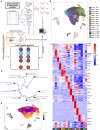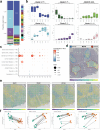Single-cell transcriptomic landscape of the neuroimmune compartment in amyotrophic lateral sclerosis brain and spinal cord
- PMID: 40728732
- PMCID: PMC12307561
- DOI: 10.1007/s00401-025-02913-3
Single-cell transcriptomic landscape of the neuroimmune compartment in amyotrophic lateral sclerosis brain and spinal cord
Abstract
Development of therapeutic approaches that target specific microglia responses in amyotrophic lateral sclerosis (ALS) is crucial due to the involvement of microglia in ALS progression. Our study identifies the predominant microglia subset in human ALS primary motor cortex and spinal cord as an undifferentiated phenotype with dysregulated respiratory electron transport. Moreover, we find that the interferon response microglia subset is enriched in donors with aggressive disease progression, while a previously described potentially protective microglia phenotype is depleted in ALS. Additionally, we observe an enrichment of non-microglial immune cell, mainly NK/T cells, in the ALS central nervous system, primarily in the spinal cord. These findings pave the way for the development of microglia subset-specific therapeutic interventions to slow or even stop ALS progression.
Keywords: Amyotrophic lateral sclerosis; Microglia; Phenotypic heterogeneity; Single-cell RNA-sequencing.
© 2025. The Author(s).
Conflict of interest statement
Declarations. Conflict of interest: The authors declare no competing interests.
Figures




Update of
-
Single-cell transcriptomic landscape of the neuroimmune compartment in amyotrophic lateral sclerosis brain and spinal cord.bioRxiv [Preprint]. 2024 Nov 14:2024.11.12.623183. doi: 10.1101/2024.11.12.623183. bioRxiv. 2024. Update in: Acta Neuropathol. 2025 Jul 29;150(1):10. doi: 10.1007/s00401-025-02913-3. PMID: 39605399 Free PMC article. Updated. Preprint.
References
-
- Ahmed RM, Devenney EM, Strikwerda-Brown C, Hodges JR, Piguet O, Kiernan MC (2020) Phenotypic variability in ALS-FTD and effect on survival. Neurology 94:e2005–e2013. 10.1212/WNL.0000000000009398 - PubMed
-
- Benjamini Y, Hochberg Y (1995) Controlling the false discovery rate: a practical and powerful approach to multiple testing. J Royal Statistical Soc 57(1):289–300
-
- Blighe K, Rana S, Lewis M (2022) EnhancedVolcano: publication-ready volcano plots with enhanced colouring and labeling
MeSH terms
Grants and funding
- R01 NS117583/NS/NINDS NIH HHS/United States
- NS107442/National Institute of Health, USA
- R01 NS107442/NS/NINDS NIH HHS/United States
- U01 AG061356/AG/NIA NIH HHS/United States
- P30 AG066462/AG/NIA NIH HHS/United States
- CS-02018-191971/Chan-Zuckerberg Neurodegeneration Challenge Network
- NS117583/National Institute of Health, USA
- S10 OD020056/OD/NIH HHS/United States
- P30 CA013696/CA/NCI NIH HHS/United States
- RF1 AG057473/AG/NIA NIH HHS/United States
- UL1 TR001873/TR/NCATS NIH HHS/United States
- AG057473/National Institute of Health, USA
LinkOut - more resources
Full Text Sources
Medical
Miscellaneous

